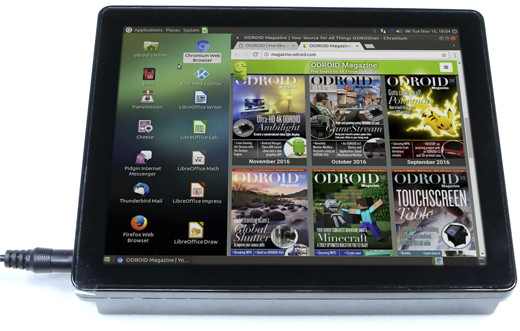
But what about that other popular single-board PC , the ‘ODROID‘, created by open-source hardware company HardKernel?
Well the answer is here, and it has a wonderfully unwieldy name.
ODROID Touchscreen Kit
Say hello to a $90 kit that takes a run-of-the-mill ODROID board and turns it into an 8″ touchscreen Ubuntu (or Android) PC.
That’s $90 without the cost of an actual ODROID, of course. But since you can nab the ODROID C1+ for as little as $32, it’s not a major drawback. For the combined cost you could probably find something ready made that’s bigger, beefier, and (granted) better at being a regular PC. But that absolutely misses who these devices are aimed at, and why they’re popular.
The ‘kit’ is formally known as the ODROID-VU8C (a name that sounds like a bad CGI robot in an equally-bad Syfy channel movie). It’s compatible with both the 2015 ODROID-C2 or the earlier ODROID C1+ (note the plus) only.
It’s not a end-user solution, and the end result looks far from elegant, but the tinkerer in me loves the craft drawer aesthetic, wirey innards all.
Back to the kit, and that $90 outlay gets you everything you need (minus the board) to get you up and interacting with Ubuntu MATE (or another flavour of your choice):
- 8″ TFT-LCD (1024×768)
- 10 finger capacitive touch input
- Back-light brightness control
- DVI to LVDS Converter board
- HDMI dual gender board
- Power Supply
- Plastic bottom case
- All necessary screws and cables
As CNX Software note, you don’t get an ODROID-C1+ or ODROID-C2 board with this kit. Nor do you get a micro SD card or eMMC module. Oh, and you’ll need to assemble it with your own hands (a thorough assembly guide is available).
But tinkering, hacking, smushing and other -ings are part of the attraction with single board computing for most, right?
Learn more, or place an order, on the HardKernel website.